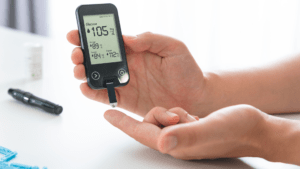November 14th is World Diabetes Day
Diabetes is one of the fastest-spreading diseases of our time. There are more than 1,200,000 diabetics in Hungary, and at least 20% have some kind of eye complication. The problem is caused by an incorrect lifestyle and inadequate eye examinations. However, early detection and regular eye examinations are crucial: with proper attention, serious vision loss can be prevented and everyday quality of life can be preserved.
 According to a statement from the World Health Organization (WHO) last November, the prevalence of diabetes among adults will have increased to 14% by 2022, with nearly 830 million people diagnosed worldwide. This is due not only to better diagnostics and easier access to doctors, but also to lifestyle changes. There are more than 1,200,000 diabetics in Hungary, and as the number of patients increases, so does the number of those with visual impairments. “Retinopathy, a disease affecting the retina of the eye, currently affects approximately 20% of diabetics. Their number is constantly increasing. The first symptoms include damage to the capillaries (microaneurysms), and macular edema may also occur, which impairs visual acuity” – says Mária Boros, an optometrist at Alensa.
According to a statement from the World Health Organization (WHO) last November, the prevalence of diabetes among adults will have increased to 14% by 2022, with nearly 830 million people diagnosed worldwide. This is due not only to better diagnostics and easier access to doctors, but also to lifestyle changes. There are more than 1,200,000 diabetics in Hungary, and as the number of patients increases, so does the number of those with visual impairments. “Retinopathy, a disease affecting the retina of the eye, currently affects approximately 20% of diabetics. Their number is constantly increasing. The first symptoms include damage to the capillaries (microaneurysms), and macular edema may also occur, which impairs visual acuity” – says Mária Boros, an optometrist at Alensa.
Many people do not notice the first common symptom of diabetes. This is a sudden change in visual acuity during the day. Higher blood sugar levels affect the optical properties of the eye. This can result in, for example, blurred vision in the morning compared to the afternoon. Symptoms of retinal damage include blurred, unsharp or distorted vision. Spots in the field of vision or a decrease in color saturation are often observed.
Screenings are key
Diabetics can avoid complications or even vision loss. Regular eye exams and lifestyle changes are essential. “It is recommended to have an eye exam at least every two years after the age of 40. If you have diabetes, you should see an eye doctor every year. “It is important not to neglect maintaining eye health: regular, timely eye exams play a key role in preventing complications. The exam is quick, painless, and can significantly contribute to preserving vision in the long term,” adds Mária Boros.
Regular control in the treatment of diabetes also provides an opportunity to reduce the direct costs of healthcare, the risk of loss of labor and premature death, as well as the burdens resulting from a deterioration in quality of life. ISPOR research found that in France, the average annual direct healthcare cost for people with type 2 diabetes was €6,614, based on 2021/2022 data. By 2040, the annual cost per person could be as high as €12,057 for type 1 diabetes patients and €8,999 for type 2 diabetes patients, according to a German study.
Related news
Mattel announces diabetic Barbie doll
🎧 Hallgasd a cikket: Lejátszás Szünet Folytatás Leállítás Nyelv: Auto…
Read more >The anteroom of diabetes: obesity triples the risk of developing diabetes
🎧 Hallgasd a cikket: Lejátszás Szünet Folytatás Leállítás Nyelv: Auto…
Read more >Neglected national disease: every year we lose a small town’s worth of Hungarians to diabetes
🎧 Hallgasd a cikket: Lejátszás Szünet Folytatás Leállítás Nyelv: Auto…
Read more >Related news
Even though the price of cocoa has halved, chocolate will not become cheaper
🎧 Hallgasd a cikket: Lejátszás Szünet Folytatás Leállítás Nyelv: Auto…
Read more >Temu is crushing domestic webshops – Christmas won’t change either
🎧 Hallgasd a cikket: Lejátszás Szünet Folytatás Leállítás Nyelv: Auto…
Read more >The Hungarian Food Bank is putting together 44,000 food packages from the proceeds of ALDI’s first Advent market
🎧 Hallgasd a cikket: Lejátszás Szünet Folytatás Leállítás Nyelv: Auto…
Read more >






